You are using an out of date browser. It may not display this or other websites correctly.
You should upgrade or use an alternative browser.
You should upgrade or use an alternative browser.
Do It Yourself: 240v from two 120v sources
- Thread starter TonyWilliams
- Start date

Help Support My Nissan Leaf Forum:
This site may earn a commission from merchant affiliate
links, including eBay, Amazon, and others.
brownga
Member
My one concern with this type of option is using it in an older home where I'm not comfortable drawing 16 amps if the receptacle circuits are only 15 amps. Is my concern misplaced? Is it possible to incorporate a switched option to allow limiting the current draw to 12 amps, and if so how would you do it? I know you could just not upgrade the EVSE to 16 amps but most of the time I'd like to use it at 16 amps, just sometimes I'd like to limit it to 12 amps.
tps
Well-known member
It's good to be concerned when electric power is involved. The short answer is, although it's not something I would do every day, it will likely work OK. A 15 amp breaker is not likely to trip at 16 amps. If the wiring is so marginal that 16 amps is a problem, it would also be a problem at 12 amps. This is why you need to check voltage under load when plugging into unknown outlets. If there's a significant voltage drop under load, regardless of how the circuit is rated, there is a problem; don't use that outlet!brownga said:My one concern with this type of option is using it in an older home where I'm not comfortable drawing 16 amps if the receptacle circuits are only 15 amps. Is my concern misplaced?
brownga
Member
How do you recommend checking the voltage "under load"? Plug the EVSE into one outlet, start charging at 120 volts and check the voltage in the other outlet? I'm assuming that just checking with a voltmeter won't provide enough load to be a valid test. Thanks.
A Kill-a-Watt plugged into the same outlet will work.brownga said:How do you recommend checking the voltage "under load"? Plug the EVSE into one outlet, start charging at 120 volts and check the voltage in the other outlet? I'm assuming that just checking with a voltmeter won't provide enough load to be a valid test. Thanks.
tps
Well-known member
brownga said:How do you recommend checking the voltage "under load"? Plug the EVSE into one outlet, start charging at 120 volts and check the voltage in the other outlet? I'm assuming that just checking with a voltmeter won't provide enough load to be a valid test. Thanks.
That would be one way. I built a meter box for that purpose.


mitch672
Well-known member
tps said:It's good to be concerned when electric power is involved. The short answer is, although it's not something I would do every day, it will likely work OK. A 15 amp breaker is not likely to trip at 16 amps. If the wiring is so marginal that 16 amps is a problem, it would also be a problem at 12 amps. This is why you need to check voltage under load when plugging into unknown outlets. If there's a significant voltage drop under load, regardless of how the circuit is rated, there is a problem; don't use that outlet!brownga said:My one concern with this type of option is using it in an older home where I'm not comfortable drawing 16 amps if the receptacle circuits are only 15 amps. Is my concern misplaced?
Another hint that Ingineer already suggested is to use 120V outlets in the kitchen or the garage, kitchen outlets in the counter area are almost always rated at 20A (for kitchen appliances such as mixers, toasters, etc), and in general adjacent 120V outlets are on different breakers, and 120V legs if your lucky.
Also, most electricians use the side screw terminals when wiring kitchen outlets, rather than the rear "faston" push-in connections, so you will have a better connection and less voltage drop on kitchen outlets as well.
91040
Well-known member
Kitchen outlets on counters are required to have GFIs, at least in my area. I think a unit combining the two 120v sources will trip the GFI.mitch672 said:Another hint that Ingineer already suggested is to use 120V outlets in the kitchen or the garage, kitchen outlets in the counter area are almost always rated at 20A (for kitchen appliances such as mixers, toasters, etc), and in general adjacent 120V outlets are on different breakers, and 120V legs if your lucky.
garygid
Well-known member
If you use the SPX 120/240v EVSE, you can select 12A, 16A, 24A, ... etc
davewill
Well-known member
It would, although a newer home that would have the GFCI, is also likely to have 20a, not 15a breakers, allowing you more choice in places to plug in.91040 said:Kitchen outlets on counters are required to have GFIs, at least in my area. I think a unit combining the two 120v sources will trip the GFI.mitch672 said:Another hint that Ingineer already suggested is to use 120V outlets in the kitchen or the garage, kitchen outlets in the counter area are almost always rated at 20A (for kitchen appliances such as mixers, toasters, etc), and in general adjacent 120V outlets are on different breakers, and 120V legs if your lucky.
brownga
Member
tps said:brownga said:How do you recommend checking the voltage "under load"? Plug the EVSE into one outlet, start charging at 120 volts and check the voltage in the other outlet? I'm assuming that just checking with a voltmeter won't provide enough load to be a valid test. Thanks.
That would be one way. I built a meter box for that purpose.


Could you post a parts list for your meter box? It looks like another fun project. Thanks.
johnr
Well-known member
Here is a photo of the innards of the easy240 device I made. 
On the far left and far right are the two relays. They are attached with double-sided padded sticky tape (specifically, Scotch brand permanent mounting squares, available at Office Depot). In the center is the L6-20 outlet. Halfway to the right you see a neon bulb and four resistors. Normally I would use a single one watt resistor, but I didn't have one handy so four 1/4 watt resistors each with 1/4 the resistance does the trick. Their function is to reduce the voltage to a suitable level for the neon bulb. The light from the neon bulb shines through a light tube, which is not visible in the photo as it is under the bulb.

And here is what it looks like outside.
There are three reasons why I use the neon-green power cord. One, it's highly visible for safety. Two, I was able to get a good price on them. Three, green is the color of being environmentally friendly.

On the far left and far right are the two relays. They are attached with double-sided padded sticky tape (specifically, Scotch brand permanent mounting squares, available at Office Depot). In the center is the L6-20 outlet. Halfway to the right you see a neon bulb and four resistors. Normally I would use a single one watt resistor, but I didn't have one handy so four 1/4 watt resistors each with 1/4 the resistance does the trick. Their function is to reduce the voltage to a suitable level for the neon bulb. The light from the neon bulb shines through a light tube, which is not visible in the photo as it is under the bulb.

And here is what it looks like outside.
There are three reasons why I use the neon-green power cord. One, it's highly visible for safety. Two, I was able to get a good price on them. Three, green is the color of being environmentally friendly.

z0ner
Well-known member
Thanks for posting, Johnr. That looks gorgeous.
garygid
Well-known member
What part numbers, and where exactly did you get them, please?
Nice Green Exrension Cords, where did you get those?
Thanks
Nice Green Exrension Cords, where did you get those?
Thanks
fooljoe
Well-known member
Gary, go back to page 9.garygid said:What part numbers, and where exactly did you get them, please?
johnr said:And here is what it looks like outside
I like the larger box a lot....the smaller box I used, everything feels very much crammed into there.
91040
Well-known member
Just successfully completed this project. Many thanks to all who posted information especially, johnr. The photos helped immensely since I have little experience with this.
What is this 120-220 really used for? 2 -120 volt plugs to make 220-240 volts ac. Are you using this to charge your leaf? I only have a 120 volt charger now. I bought a wrecked Leaf but running and will need a 220 level 2 charger later. I beleave there is more than running 220v to the Leaf? :shock:
EVDRIVER
Well-known member
- Joined
- Apr 24, 2010
- Messages
- 6,753
broncoa said:What is this 120-220 really used for? 2 -120 volt plugs to make 220-240 volts ac. Are you using this to charge your leaf? I only have a 120 volt charger now. I bought a wrecked Leaf but running and will need a 220 level 2 charger later. I beleave there is more than running 220v to the Leaf? :shock:
Yes, it is used by many to plug in their modified EVSE from evseupgrade into so they can charge at 240V off two separate 120V circuits. The plug on the modified EVSE plugs right into the box. This is handy for traveling, at a friends with no 240 outlet, etc.
Just completed my version of the Quick240 using Phil's version 2 circuit (sound and light). I added a volt meter to measure voltage before and after starting a charge. Meter was from ebay $7 shipped.
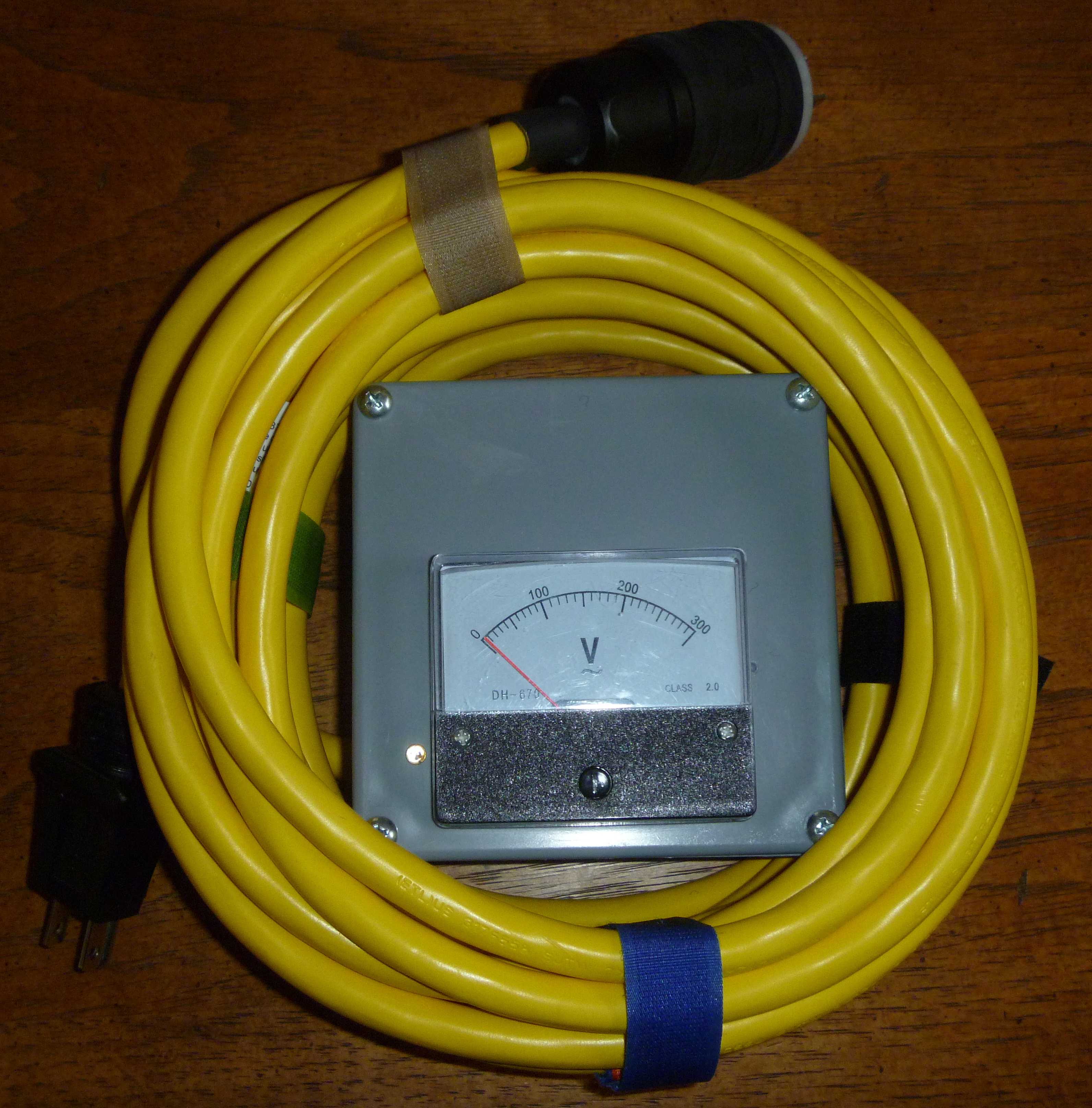
The bottom section houses all the high power 240v wire/parts. Power cord is from a 50' extension cord from Fry's. I used only 25' of it so have a 25' 12 guage extension cord too for the same price. Extension cord costs only around $25. Note the two thin wires that connect to the top section meter terminals. The 240v outlet is mounted on the side so the box can lay flat with all wires coming out the sides and gives me room for the meter on top.
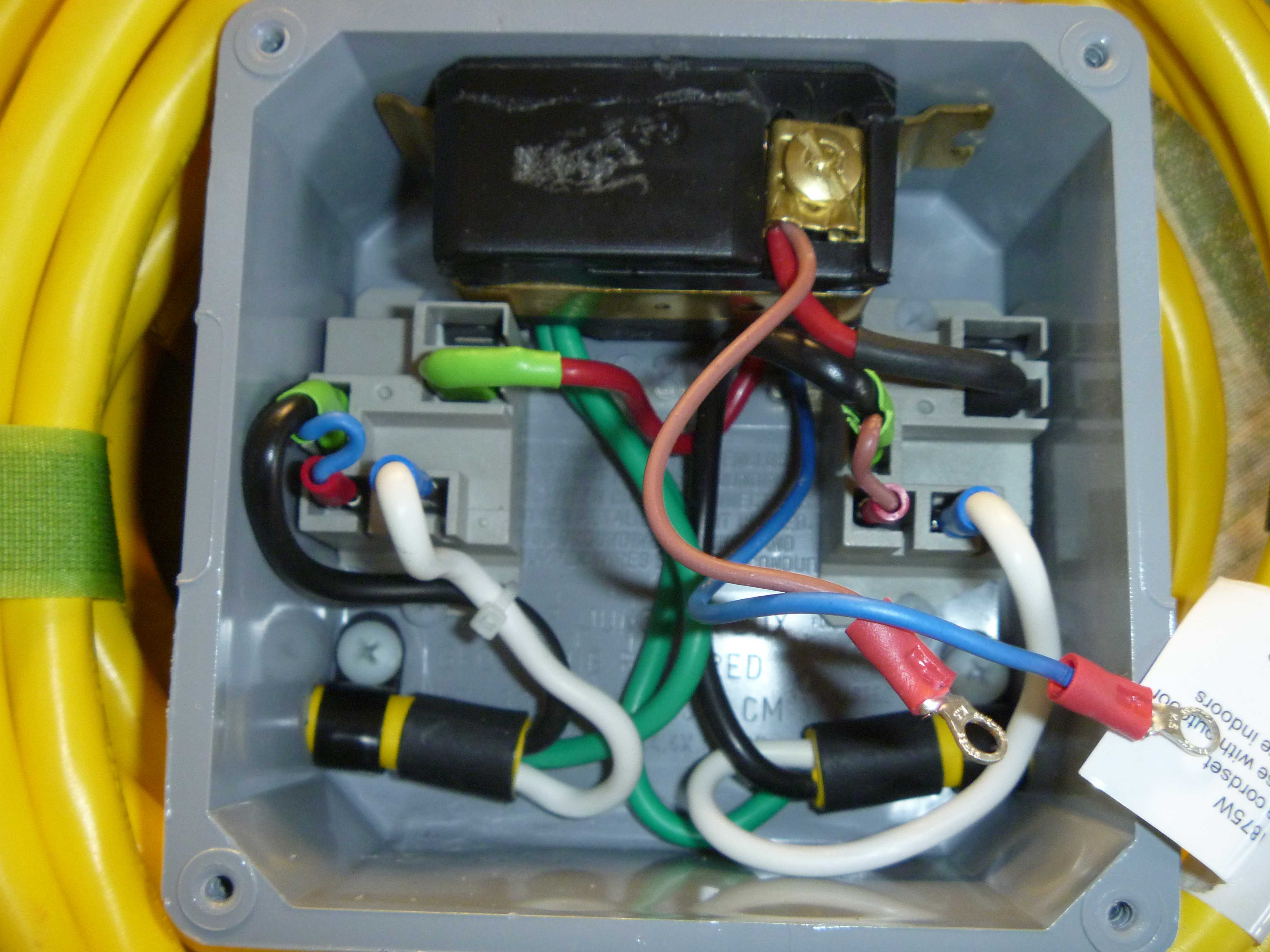
Top holds the meter and all DC logic. Two wires (Brown & Blue) from bottom section connect to meter to supply the 240v.
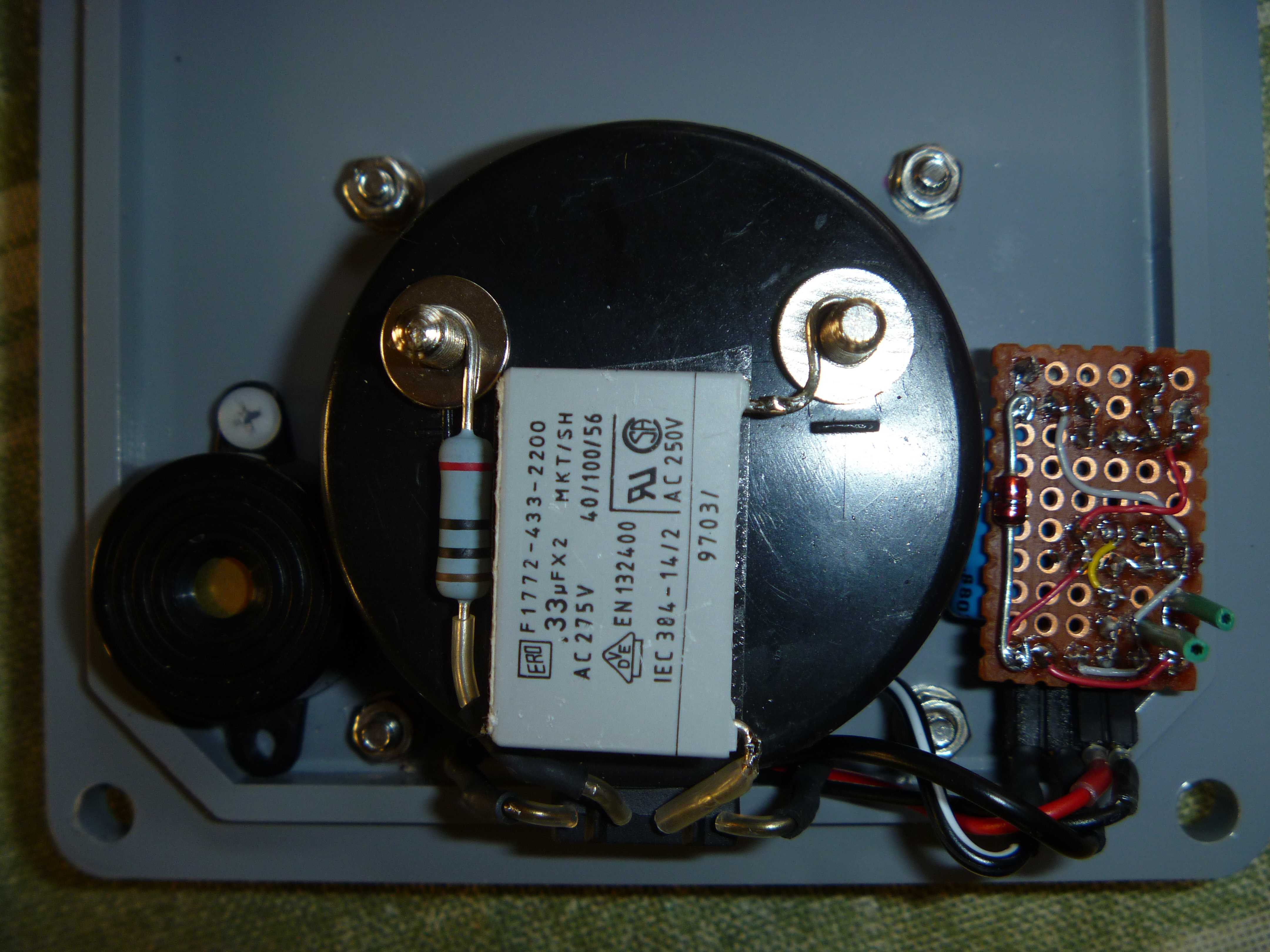
More views of the top. Two leads from LED help hold logic board.
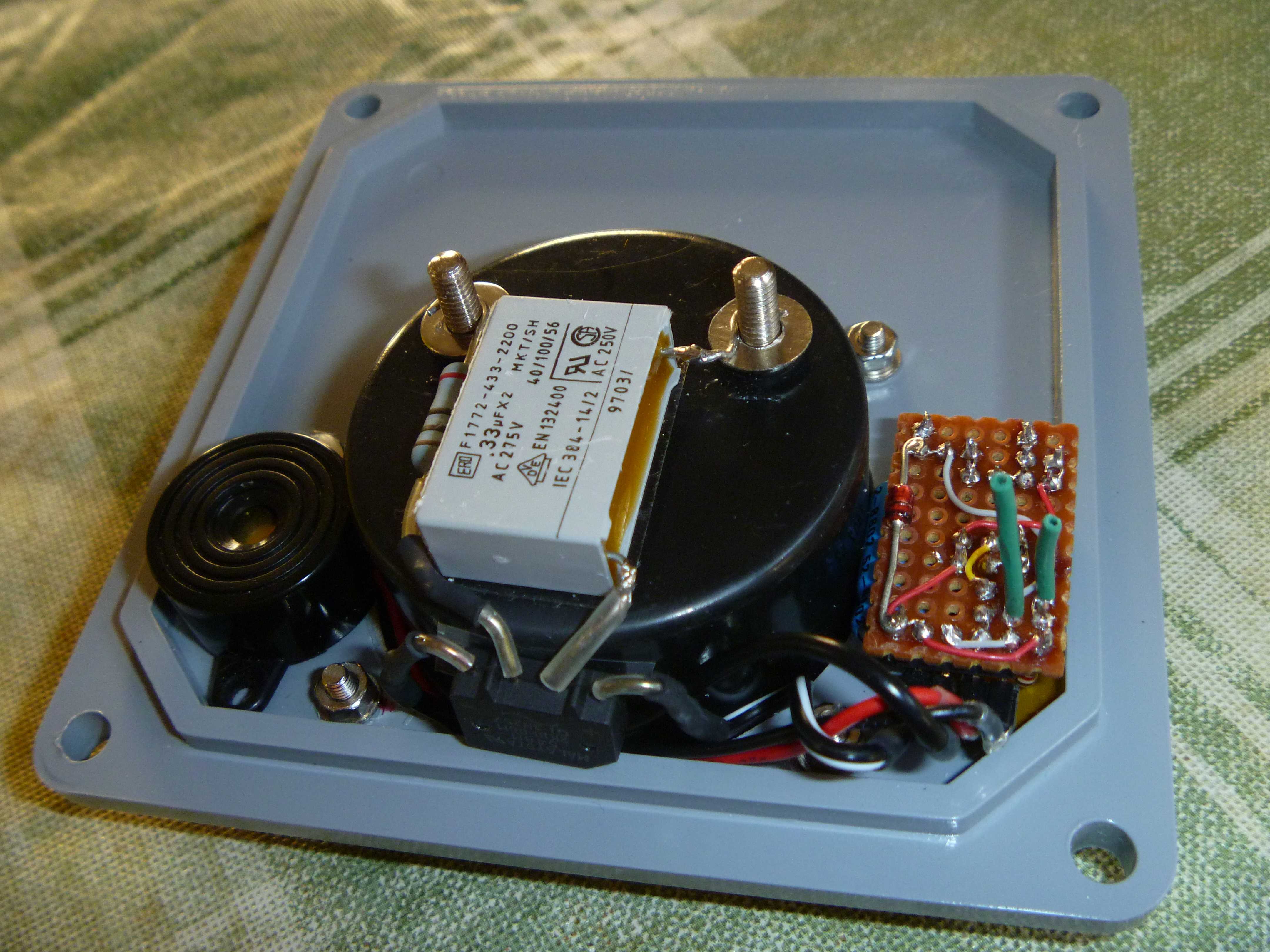
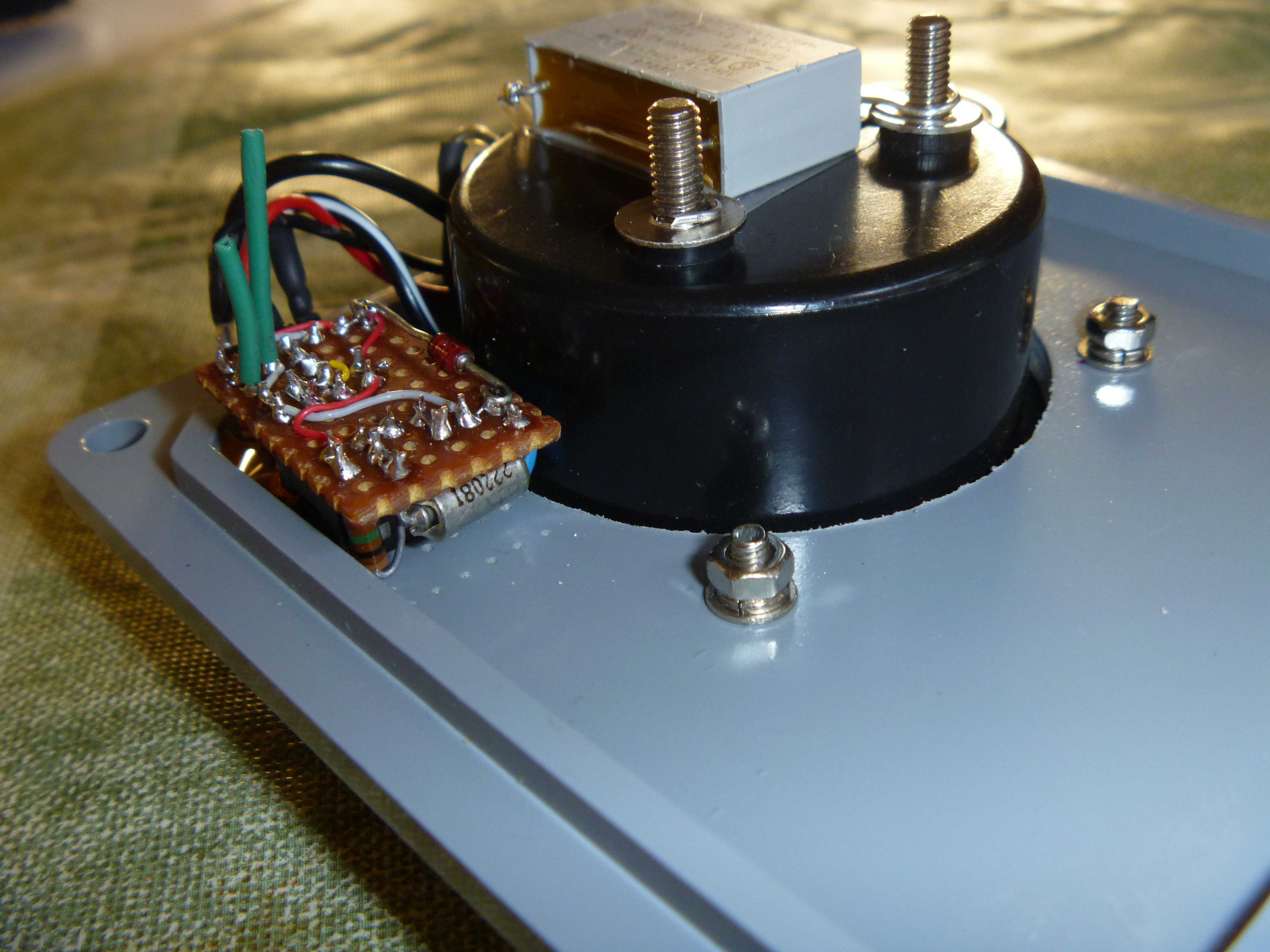
If the meter shows more than a few volt drop when charging starts that would be a good indication that power is being lost in the house wiring and charging should be immediately terminated. Don't want to burn down a friend's house do we?
Four Velcro straps are permanently attached to the cables using loops already on the Velcro ends that the yellow cable just fits through. (two each line).
Thanks to Phil for the sound circuit. Makes it much easier to find the right second outlet. Just plug and listen.
Jim

The bottom section houses all the high power 240v wire/parts. Power cord is from a 50' extension cord from Fry's. I used only 25' of it so have a 25' 12 guage extension cord too for the same price. Extension cord costs only around $25. Note the two thin wires that connect to the top section meter terminals. The 240v outlet is mounted on the side so the box can lay flat with all wires coming out the sides and gives me room for the meter on top.

Top holds the meter and all DC logic. Two wires (Brown & Blue) from bottom section connect to meter to supply the 240v.

More views of the top. Two leads from LED help hold logic board.


If the meter shows more than a few volt drop when charging starts that would be a good indication that power is being lost in the house wiring and charging should be immediately terminated. Don't want to burn down a friend's house do we?
Four Velcro straps are permanently attached to the cables using loops already on the Velcro ends that the yellow cable just fits through. (two each line).
Thanks to Phil for the sound circuit. Makes it much easier to find the right second outlet. Just plug and listen.
Jim
Similar threads
- Replies
- 11
- Views
- 6K
- Replies
- 2
- Views
- 1K
- Replies
- 7
- Views
- 5K